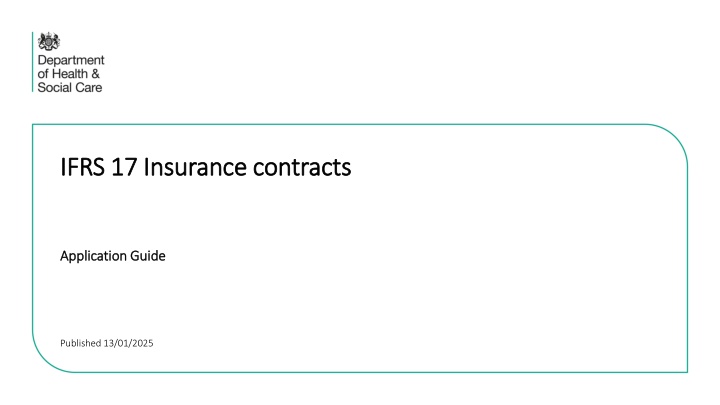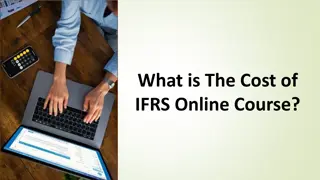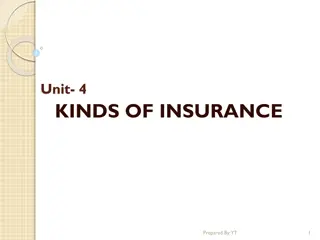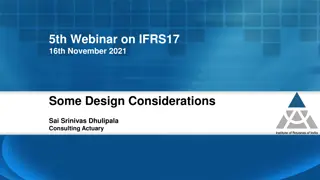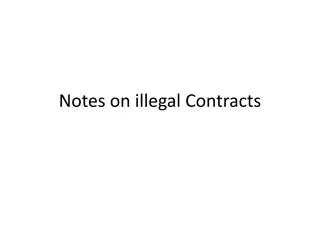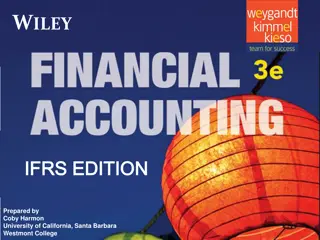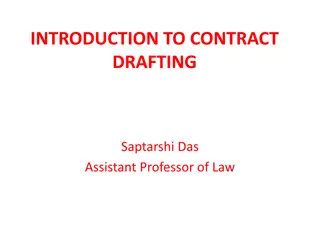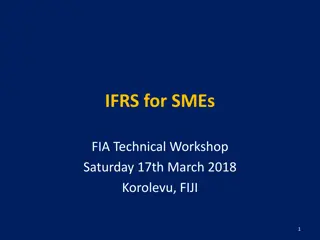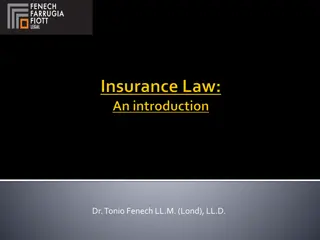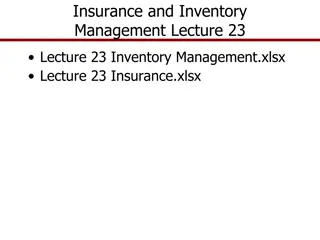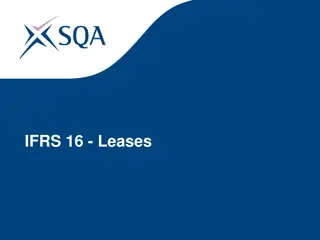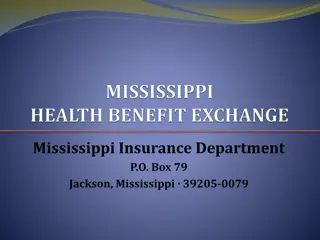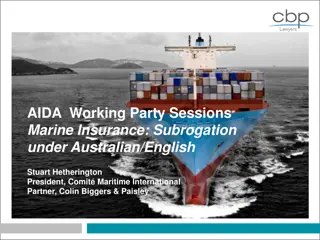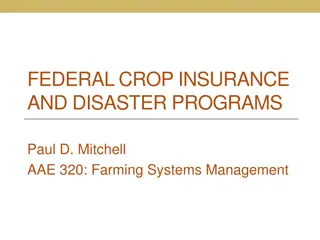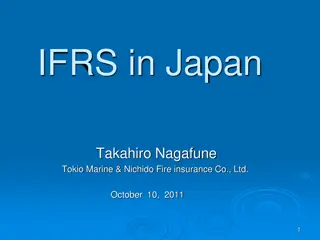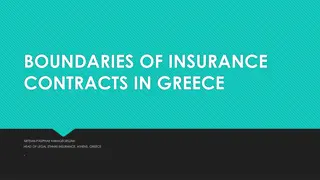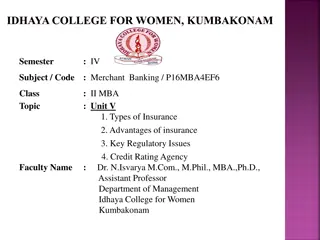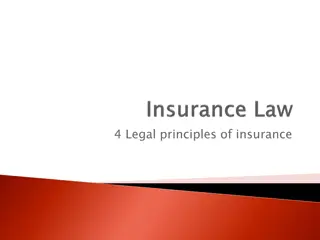Key Principles of IFRS 17 Insurance Contracts
IFRS 17 replaces IFRS 4 to provide comprehensive accounting requirements for insurance contracts, ensuring consistent recognition, measurement, and presentation in financial statements. Key principles include separate identification of insurance contracts, immediate recognition of losses, and disclosure of information to assess financial impact.
Uploaded on Mar 18, 2025 | 0 Views
Download Presentation

Please find below an Image/Link to download the presentation.
The content on the website is provided AS IS for your information and personal use only. It may not be sold, licensed, or shared on other websites without obtaining consent from the author.If you encounter any issues during the download, it is possible that the publisher has removed the file from their server.
You are allowed to download the files provided on this website for personal or commercial use, subject to the condition that they are used lawfully. All files are the property of their respective owners.
The content on the website is provided AS IS for your information and personal use only. It may not be sold, licensed, or shared on other websites without obtaining consent from the author.
E N D
Presentation Transcript
IFRS 17 Insurance contracts IFRS 17 Insurance contracts Application Guide Application Guide Published 13/01/2025
Matters covered in this application guide Matters covered in this application guide 1 Slide 3 Background to IFRS 17 2 Slide 6 How to identify an insurance contract under IFRS 17 3 Slide 14 Scoping and contractual considerations for IFRS 17 4 Slide 23 Accounting for elements of Insurance Contracts 5 Slide 38 Budgeting under IFRS 17 6 Slide 43 HMT Interpretations and adaptations for IFRS 17 7 Slide 47 Steps to implementation and implementation aides
Background to IFRS 17 Background to IFRS 17
Why IFRS 17 is replacing IFRS 4 Why IFRS 17 is replacing IFRS 4 IFRS 4 defined insurance contracts and this content is carried forward in IFRS 17. However, IFRS 4 allowed entities to use a wide variety of approaches in accounting for insurance contracts. In contrast IFRS 17 provides comprehensive accounting requirements for insurance contracts. Government entities may issue contracts that have the legal form of insurance but may not be insurance; some contracts that don t have the legal form of insurance may be insurance. IFRS 17 requires these contracts to be consistently recognised, measured and presented in financial statements in accordance with its principles to allow users to more fully assess how public money is being allocated to cover insurance risks by government entities implicitly or explicitly issuing insurance contracts.
Key principles of IFRS 17 Key principles of IFRS 17 Identify insurance contracts separately from other non-insurance components grouping similar contracts. Recognise insurance obligations when they first arise including when they become onerous. Recognise losses immediately but recognise gains over the period of insurance coverage. Use DCF to measure claims and fulfilment obligations reflecting risk and time value of money through appropriate discount rates. Present operating revenue and expenses separately from financing income and expenses. Disclose information that allows the impact on the entity s financial performance, position and cash flows to be assessed.
How to identify an insurance contract under IFRS 17 How to identify an insurance contract under IFRS 17
The elements of insurance contracts The elements of insurance contracts Definition of an insurance contract: An insurance contract is a contract under which one party (the issuer) accepts significant insurance risk from another party (the policyholder) by agreeing to compensate the policyholder if a specified uncertain future event (the insured event) adversely affects the policyholder. Contractual agreement between two parties exists and the enforceable rights and obligations are accepted by the parties The contract transfers significant pre- existing insurance risks from the policyholder to the issuer Elements of an insurance contract under IFRS 17 Specified uncertain future event exists Specified uncertain future event adversely affects the 3rd party
What is a legally enforceable contract? What is a legally enforceable contract? A contract is described in IFRS 17 as an agreement between two or more parties that creates enforceable rights and obligations. Enforceability of the rights and obligations is a matter of law. Contracts can be written, oral or implied by an entity s customary business practices. Unlike other contract standards such as IFRS 15 and IFRS 16, IFRS 17 does not cover intra government arrangements that are not legally enforceable. Legislation and regulations are not insurance contracts. Legislation is not a contract between the Government and individuals or entities, so responsibilities conferred by legislation on the NHS to provide healthcare services is not an insurance contract between the NHS and individuals. Contracts that are subject to similar risks and are managed together form a portfolio of insurance contracts. IFRS 17 includes guidance on how to aggregate insurance contracts which is not adapted or interpreted by the FReM.
The definition of insurance risk The definition of insurance risk Insurance risk is any risk that is not a financial risk. IFRS 17 defines a financial risk as; The risk of a possible future change in one or more of a specified interest rate, financial instrument price, commodity price, currency exchange rate, index of prices or rates, credit rating or credit index or other variable, provided in the case of a non-financial variable that the variable is not specific to a party to the contract.
Financial risk compared to insurance risk Financial risk compared to insurance risk FINANCIAL RISK INSURANCE RISK The risk of a possible future change in a specified rates such as financial instrument price, commodity price, currency exchange rate, index, credit rating or; Any risk that is not a financial risk. Non-financial variable not specific to the insured e.g. an index of earthquake losses or weather derivative. Risk specific to the insured such as cover for risk of premises being damaged from flooding or fire. Assumptions about inflation based on an index of prices or rates or on assets with inflation linked returns relates to financial risk. Payments can be linked to a price index and still be insurance if payments on insured event is significant - annuity until death has a non-financial variable mortality risk specific to the insured. Transfer of risk not covered by IFRS 17. Transfer covered by IFRS 17 if significant in the contract.
Contract transfers significant insurance risks Contract transfers significant insurance risks Insurance risk is significant if, and only if, an insurance event could cause the issuer to pay additional amounts that are significant in any single scenario, excluding scenarios which have no commercial substance. Scenarios with no commercial substance are those that have no discernible effect on the economics of the transaction. If significant additional amounts are payable in a scenario, the contract is considered to transfer significant insurance risk even if the insured event is extremely unlikely, or if the expected present value of contingent cash flows is a small proportion of the expected present value of all the remaining contractual cash flows. Additional amounts are those exceeding those payable if no insured event had occurred. An entity should assess the significance of insurance risk contract by contract. Insurance risk can be significant even if there is low probability of significant losses for a portfolio or group of contracts focus is the existence of a scenario in which the issuer has a possibility of a loss on a present value basis arising in a contract.
Pre Pre- -existing insurance risks existing insurance risks To be considered an insurance risk under IFRS 17 the risk must be pre-existing. This means the entity must accept from the policyholder a risk to which the policyholder was already exposed. New risks created by the contract for the entity or policyholder are not insurance risk. Consider a scenario in which a person/ entity is buying or leasing a car and taking out insurance cover for it. There is a pre-existing risk of incurring a liability (an adverse effect) if a specified uncertain future event occurs(an accident occurs while driving the car) when cover is agreed with the policyholder. So, a pre-existing risk need not be overly historical. An example of a more historically formed pre-existing risk may occur where flood risk is covered by an insurance policy due to a history of floods and related damage to property in a certain area. The tool kit at the back of this pack gives some further insights into pre-existing risks in different types of contracts and questions that may help determine the nature of the risk.
Uncertain future event exists that adversely affects the Uncertain future event exists that adversely affects the policyholder policyholder One of the following uncertain at the inception of an insurance contract: the probability of an insured event occurring; when the insured event will occur; or how much the entity will need to pay if the insured event occurs. The insured event can relate to losses discovered during the term of the contract even if the losses arose from an event that occurred before the inception of the contract. Insurance contracts can cover insured events that occur during the term of the contracts even if the event is discovered after the end of the contact term and events that have already occurred but the financial effect of which is still uncertain, e.g., the discovery of the ultimate cost of claims for events that have already occurred.
Scoping and contractual considerations for IFRS 17 Scoping and contractual considerations for IFRS 17
Contracts that are exempt from the scope of IFRS 17 Contracts that are exempt from the scope of IFRS 17 Warranties (IFRS 15, IAS 37), Employers assets (IFRS 2 Share based payments) Contractual rights and obligations contingent on the future use of, or right to use, a non-financial item (IFRS 15, IAS 38, IFRS 16, etc.), Contingent consideration payable in a business combination (IFRS 3) Financial guarantee (IFRS 9), Residual value guarantee except those that are not embedded in the lease contract, Insurance contracts that limit compensation to the amount required to settle the policyholder s obligation created by the contract (IFRS 9).
Self Self- -insurance contracts between central government insurance contracts between central government bodies bodies Central government entities generally self-insure against risks as this represents value for money as referenced in Managing Public Money. Such self-insurance is not within the scope of IFRS 17. Where a department provides an insurance service via contract to its ALBs by agreeing to cover claims to damage incurred, at the group level the transactions between the two entities associated eliminate on consolidation. At the entity level there may be an insurance contract if it is determined there is a contract in place between the department and its ALBs, with the department taking on significant insurance risk. If an entity chooses to bear the risk of an uncertain future event adversely affecting them, this arrangement would be outside the scope of IFRS 17, as there is no agreement with another party.
Reinsurance contracts between government bodies Reinsurance contracts between government bodies Reinsurance under IFRS 17 is an insurance contract issued by one entity (the reinsurer) to compensate another entity for claims arising from one or more insurance contracts issued by that other entity (underlying contracts). An entity will have a reinsurance contract if it agrees to provide cover to another entity that has issued an insurance contract to a third party. A department may reinsure for one of its arm s length bodies (ALB) for example. An entity which purchased reinsurance would recognise both the insurance contract and the reinsurance contract separately in its financial statements. If the insurance contract was a liability for the ALB and the department had agreed to cover the whole cost of the risk crystallising, then the reinsurance contract would be a corresponding asset and the net impact would be zero, assuming there are no timing differences in recognition of the insurance contract and reinsurance contract.
Fixed fee service contracts Fixed fee service contracts IFRS 17 provides a scope exception so that fixed fee contracts may be accounted for under either IFRS 15 or IFRS 17. An entity may fix the fee agreed with a contractor for the provision of services under a maintenance contract, which could meet the definition of an insurance contract. The accounting policy choice allowed under IFRS 17 to account for these contracts under IFRS 15 and IFRS 17 has been withdrawn by the FReM, instead mandating that these contracts should be accounted for under IFRS 15 if: the entity does not reflect an assessment of the risk associated with an individual customer in setting the price of the contract with that customer, the contract compensates the customer by providing services, rather than by making cash payments to the customer, and the insurance risk transferred by the contract arises primarily from the customer s use of services rather than from uncertainty over the cost of those services.
Financial guarantee contracts Financial guarantee contracts Financial guarantee contracts require the issuer to reimburse the holder for a loss it incurs due to a specified debtor failing to make the payments due in accordance with the terms of a debt instrument. IFRS 17 explicitly excludes from its scope financial guarantee contracts unless the issuer has previously asserted explicitly that it regards such contracts as insurance contracts and has used accounting applicable to insurance contracts. The accounting policy choice in IFRS 17 paragraph 7(e) is withdrawn per the FReM. All entities shall account for financial guarantee contracts using IAS 32, IFRS 7 and IFRS 9.
Decision tree considering whether IFRS 17 applies Decision tree considering whether IFRS 17 applies
Modification Modification Derecognition of the original contract and recognition of the modified contract as a new contract, applying IFRS 17 or other applicable Standards should occur if, and only if, any of the conditions in (a) (c) of paragraph 72 are satisfied. This includes: the existing contract would have been excluded from IFRS 17 if the modified terms had been included at the inception of the contract, the modification would entail separating different components from the host (as in paras 10-13) leaving a different insurance contract in place, the modified contract would have had a substantially different contract boundary applying paragraph 34. If a contract modification meets none of the above conditions in paragraph 72, the entity shall treat changes in cash flows caused by the modification as changes in estimates of fulfilment cash flows. The exercise of a right included in the terms of a contract is not a modification.
Derecognition An entity shall derecognise an insurance contract when, and only when it is: extinguished, i.e., when the obligation specified in the insurance contract expires or is discharged or cancelled, or modified and replaced with a new insurance contract, transferred to a third party. When an insurance contract is extinguished, the entity is no longer at risk and is therefore no longer required to transfer any economic resources to satisfy the insurance contract. When an entity buys reinsurance, it shall derecognise the underlying insurance contract(s) when, and only when, the underlying insurance contract(s) is or are extinguished.
Accounting for elements of Insurance Contracts Accounting for elements of Insurance Contracts
Accounting for insurance liabilities on the SoFP Accounting for insurance liabilities on the SoFP The value of the IFRS 17 insurance contract liability on the SoFP is made up of several separate moving parts. Each element contributes to creating a full, updated picture of the insurance provider s commitments.
The moving parts of the contract liability The moving parts of the contract liability Both the liability for incurred claims and the liability for the remaining coverage are measured at current value at every SoFP date. In both cases this is achieved by calculating the present value of future cash flows and then making a risk adjustment. This is graphically represented below: Both insurance and reinsurance contracts are measured using a probability-weighted average estimate of all future cash flows within the contract boundary with a risk adjustment to reflect the uncertainty in the timing and amount of cash flows that arises from non-financial risk. Determining which cash flows should be included is an area of judgement. Cash flows are within the contract boundary if they arise from substantive rights and obligations imposed by the contract that exist during the reporting period and directly related to the fulfilment of the contract.
Discount rates to use Discount rates to use Under IFRS 17 the discount rates used to measure the present value of future cash flows need to reflect not just the time value of money but also liquidity characteristics of the insurance contracts themselves. HM Treasury currently provide central discount rates to be used in the accounting for financial instruments, leases, provisions, and pensions. HM Treasury therefore adapts IFRS 17 in respect of discount rates to have a rebuttable presumption that the financial instrument discount rate stated in the PES paper is used to discount IFRS 17 liabilities, except for regulated insurers and entities whose principal business is insurance or reinsurance activities. Where entities use the PES discount rate reporting entities do not need to disclose the yield curve required by paragraph 120 as a further adaptation in this area.
Risk adjustment for non Risk adjustment for non- -financial risk financial risk The risk adjustment is the compensation an entity requires for bearing the uncertainty about the amount and timing of the cash flows that arises from non-financial risk as the entity fulfils insurance contracts. It is calculated from the perspective of the issuer. Whilst IFRS 17 doesn t specify estimation techniques to employ it does provide a list of characteristics the adjustment should have in paragraph B91 including that where risks with low frequency and high severity will have higher adjustments than high frequency and low severity risks and when looking at similar risks a contract with a longer duration will have a higher risk adjustment than those with contracts of a shorter duration. There are several disclosure requirements associated with the risk adjustment, one of which is paragraph 119 of IFRS 17, requiring entities to disclose the confidence level used. However, this requirement has been withdrawn as a HMT adaptation.
Contractual service margin Contractual service margin The contractual service margin (CSM); represents the unearned profit on an insurance contract or group of insurance contracts, relates to future service to be provided under the insurance contracts issued by the entity, represents the margin theentity has charged for the insurance services it is providing in addition to bearing risk. This unearned profit is recognised over the coverage period of that contract (or group of contracts) as and when insurance services are provided by the insurer to the policyholder. If the expected present value of cash inflows related to a group of insurance contracts are greater than the expected present value of cash outflows that difference is the profit for that group of contracts. The unearned element, updated at each SoFP date, is the contractual service margin, forming part of the insurance contract liability. The CSM is the balancing figure included on the SoFP to avoid profit being recognised on day 1.
Onerous contracts Onerous contracts When an insurance contract is issued and the expected cash outflows are expected to exceed inflows, the insurance contract is onerous. The CSM cannot depict unearned losses. If a contract or group of contracts is onerous from inception or becomes onerous so that no profit is ever anticipated, then there is no contractual service margin. In the case of onerous contracts, the loss on the contracts is recognised through income and expenditure immediately as insurance service expenditure.
Statement of consolidated net expenditure (SOCNE) Statement of consolidated net expenditure (SOCNE) In each period the entity recognises the revenue for the coverage provided in that period, as well as any expenses incurred in that period. As time passes some of the uncertainty associated with the original insurance contract(s) is reduced, and the risk adjustment is accordingly released. IFRS 17 paragraphs 41 and 42 set out the amounts recognised as income and expense. To ensure consistency of accounting all entities shall recognise insurance finance income and expense for the period in the SoCNE.
Models for accounting for insurance contracts Models for accounting for insurance contracts There are three models for accounting for insurance contracts in IFRS 17: The General Measurement Model (GMM) described in the previous slides and expected to apply for entities in the health sector applying IFRS 17. The Premium Allocation Approach (PAA) is a simplified model that can be employed to a group of insurance contracts if; The entity expects simplification would produce a measurement for remaining coverage that wouldn t materially differ from the one produced applying GMM, or The coverage period of each contract in the group is one year or less. The extent to which this may be employed in the health sector is expected to be limited. The Variable Fee Approach (VFA) - used for groups of investment contracts with discretionary participation features. Such contracts are unlikely to be common in the health sector.
Transition Transition The date of initial application across the public sector is 1 April 2025. On transition entities shall apply IFRS 17 on a fully retrospective basis. The transition date is the beginning of the annual reporting period immediately preceding the date of initial application, so 1 April 2024. Per paragraph C3(a) an entity is not required to present quantitative information required under IAS 8 28(f) so no requirement to present the amount of adjustment to financial statement line items. There are several considerations to evaluate as part of the transition to IFRS 17 including; Inform, train and support stakeholders about the requirements and applications of the Standard, Identifying and grouping contracts, Assessing materiality for disclosure.
Alternative approach to transition: Fair value approach Alternative approach to transition: Fair value approach If full retrospective restatement is impracticable, entities shall apply the fair value approach per IFRS 17 paragraphs C20-C24. As noted in IAS 8 entities must make every reasonable effort to apply a new standard retrospectively before concluding impracticability. The insurance liability at transition using the fair value approach is measured at the higher of the fulfilment cashflows and fair value amount (these are graphically illustrated in the slides below): The fair value approach calculates CSM prospectively on the transition date (1 April 2024). If the fair value amount is higher than the fulfilment cashflows at transition, then the insurance liability is measured at the fair value amount. There is a CSM in this scenario, being the difference between the fair value and the fulfilment cashflows at transition. If the fair value is less than the fulfilment cashflows then the insurance liability at transition is measured at the fulfilment cashflows amount. There is a loss component in this scenario, being the difference between the fair value amount and the fulfilment cashflows at transition.
The insurance liability at transition: fulfilment cash The insurance liability at transition: fulfilment cash flows vs fair value flows vs fair value
FReM adaptation regarding fulfilment cashflows FReM adaptation regarding fulfilment cashflows For insurance contracts where a nil premium is charged and the fair value approach is being used to transition to IFRS 17 for those contracts, entities must measure the transition value of those contracts at fulfilment cashflows. This is to avoid situations where the transition value of insurance contracts with a nil premium charged results in a significant CSM being recognised on transition for central government contracts. The IFRS 17 measurement basis allows the recognition and measurement of insurance liabilities on a more realistic and consistent basis reflecting the entity s risk profile and cash flow characteristics more closely than market participant s assumptions about identical exit values under IFRS 13.
Disclosure Disclosure Except where excluded by the HMT s adaptations an entity shall disclose qualitative and quantitative information about: a) the amounts recognised in its financial statements for contracts within the scope of IFRS 17, covering only the key elements (see paragraphs 97 116), b) the significant judgements, and changes in those judgements, made when applying IFRS 17 (see paragraphs 117 118), and c) the nature and extent of the risks from contracts within the scope of IFRS 17 (see paragraphs 121 132). Note that on transition the impact on each financial statement line item is not required to be disclosed. The HMT s adaptations remove the following disclosure requirements: - the requirement in paragraph 119 to disclose the confidence level used to determine the risk adjustment for non-financial risk. - the requirement in paragraph 120 to disclosethe yield curve where entities use financial instrument discount rate stated in PES papers. The transition relief noted in IFRS 17 paragraph C28 is mandated in which an entity need not disclose previously unpublished information about claims development occurring five years before 31 March 2026.
Budgeting under IFRS 17 Budgeting under IFRS 17
Budgeting approach to IFRS 17 Budgeting approach to IFRS 17 Under IFRS 17, insurance liabilities will be accounted for in a more consistent way than under IFRS 4. The budgeting treatment reflects both IFRS and national accounts impacts. There are similarities to provisions treatment, but insurance expenditure will score to CDEL The budgeting treatment recognises the movements of the liability on the SoFP as well as the initial recognition and any movements that appear in the SoCNE. It does however score insurance expenditure to CDEL. Entities need to be aware that income and expenditure movements relating to insurance contracts will score to different budgeting currencies. Scoring the separate elements to the transaction in this way ensures that the information required for the national accounts is available and allows HM Treasury to control spending in support of the fiscal framework. The HMT guidance gives worked examples two of which are reproduced in the following slides after providing a quick refresher on budgeting for provisions.
Budgeting for provisions Budgeting for provisions
Budgeting for onerous IFRS 17 contract Budgeting for onerous IFRS 17 contract
Budgeting for profitable IFRS 17 contract Budgeting for profitable IFRS 17 contract
HMT interpretations and adaptations for IFRS 17 HMT interpretations and adaptations for IFRS 17
HMT interpretations in the HMT interpretations in the IFRS 17 Application Guidance IFRS 17 Application Guidance For the purpose of applying IFRS 17 in central government, legislation and regulations, in isolation, are not equivalent to insurance contracts. Legislation and regulations can include binding rights or obligations, can facilitate the creation of arrangements that fall within the definition of a contract and can form part of the implied terms of a contract, but in themselves are not agreements between parties. The accounting policy choice to account for contracts meeting the criteria set out in IFRS 17 paragraph 8 has been withdrawn. All entities applying the FReM shall account for contracts meeting the criteria in IFRS 17 paragraph 8 under IFRS 15. The accounting policy choice in IFRS 17 paragraph 7(e) is withdrawn. All entities shall account for financial guarantee contracts using IAS 32, IFRS 7 and IFRS 9. The accounting policy choice under IFRS 17 paragraphs 88 and 89 has been withdrawn. All entities shall follow IFRS 17 paragraphs 88(a) and 89(a) and recognise insurance finance income and expense for the period in the SoCNE. For insurance contracts that limit the compensation for insured events to the amount otherwise required to settle the policyholder s obligation created by the contract (for example, loans with death wavers), entities shall account for these contracts under IFRS 9.
HMT Interpretations continued HMT Interpretations continued If an entity has reasonable and supportable information to conclude that a set of contracts will all be in the same group applying IFRS 17 paragraph 16, it shall measure the set of contracts to determine if the contracts are onerous and assess the set of contracts to determine if the contracts have no significant possibility of becoming onerous subsequently. In applying the premium allocation approach, an entity shall recognise any insurance acquisition cash flows as expenses when it incurs those costs, provided that the coverage period of each contract in the group at initial recognition is no more than one year. Entities shall include the entire change in the risk adjustment for nonfinancial risk as part of the insurance service result. An entity shall present the income or expenses from a group of reinsurance contracts held (see paragraphs 60 70A), other than insurance finance income or expenses, as a single amount. Entities shall include insurance finance income or expenses for the period in the SoCNE. On transition entities shall restate retrospectively following the requirements of IFRS 17 paragraphs C3-C4. If full retrospective restatement is impracticable, entities shall apply the fair value approach per IFRS 17 paragraphs C20-C24.
HMT adaptations HMT adaptations There is a rebuttable assumption that the financial instrument discount rate provided in PES papers will be used to discount IFRS 17 insurance liabilities, except for insurers regulated by the Prudential Regulation Authority (PRA) and entities whose principal business activity is insurance or reinsurance. Where entities use the financial instrument discount rate stated in PES papers, reporting entities do not need to disclose the yield curve used to discount cash flows as required by IFRS 17 paragraph 120. The requirement of IFRS 17 paragraph 119 to disclose the confidence level used to determine the risk adjustment for non-financial risk has been withdrawn. For insurance contracts where a nil premium is charged and the fair value approach is being used to transition to IFRS 17 for those contracts, entities must measure the transition value of those contracts at fulfilment cashflows.
Steps to implementation and implementation aides Steps to implementation and implementation aides
Work to discover potential insurance contracts Review underlying contracts for possible insurance risks Review judgements between financial and insurance risk arising Consider the possibility and criteria for reclassification between other standards and IFRS 17 for instance contingent liabilities may be an area in which transfer of significant non-financial risk occurs IFRS 17 imposes no limitations on when contracts can be assessed for significant insurance risk. Additional training materials can be found Additional training materials can be found on the GFF One Finance page at the below on the GFF One Finance page at the below link link This slide pack gets you started but isn t a substitute for HMT s guidance or IFRS 17 which must be read to get the full technical understanding. Technical Accounting Training ( Technical Accounting Training (TAcT TAcT) )
Insurance Contract Toolkit The toolkit gives specific examples to help with identifying insurance risk within contracts and as such supplements Appendix 1 in HMT s Application Guidance which helps with identifying insurance contracts. The toolkit is in two parts: The first part of the toolkit provides some basic questions and scenarios to aide identification of insurance contracts. The distinction between insurance risk financial risk is included as a differentiator to delineate insurance risk. The second part of the toolkit develops a starter for 10 questionnaire for entities to consider when developing considerations around the implementation and impact of IFRS 17.
Scenario A contract protects the policyholder against the risk of adverse movements in exchange rates A contract provides for payment up to 10m in the event that flooding causes damage to the entity s property rendering the property unsafe for use. Floods can happen in the area there is a c30% risk of this happening and the entity would be adversely affected by the occurrence. The policyholder What is the pre-existing risk? Exchange rates can move adversely against balances and transactions. Who is exposed to the risk? Entities exposed to changes in the exchange rate including the policyholder n/a Financial The non-financial variable is What is the nature of the risk? Specific Non-financial What is the type of risk? Is the insurance risk transferred by the contract significant? Financial risk n/a Insurance risk Yes. In at least one scenario that has commercial substance the insurer compensates the policyholder for the loss suffered from the specified future event. The additional amount represents a present value loss to the insured because it exceeds the amount that would have been paid had the insured event not occurred. Modifying the contract can result in the initial contract being derecognised and replaced with a new contract, or there being changes in the estimates of fulfilment cashflows. Implications of the contract being modified New terms need to be assessed for whether they create a transfer of significant non-financial risk, though considered unlikely
